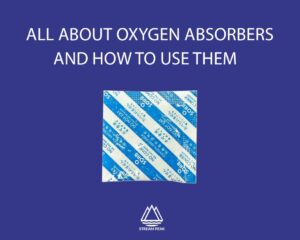
All About Oxygen Absorbers and How to Use Them
Oxygen Absorbers are made of non-toxic and non-hazardous materials. The packaging absorber help removes oxygen from sealed environments, resulting in a nitrogen environment suitable for long-term food storage. Oxygen Absorbers help protects dry foods from insects and preserves product quality.
Oxygen Absorbers are commonly used for these applications.
- Bread, cookies, cakes, and pies
- Snacks and nuts
- Sweets and confectioneries
- Tea and coffee
- Dry whole-fat foods
- Meats that have been processed, smoked, or cured Dairy products and cheese
- Fruits and vegetables, dried
- Seasonings and spices
- Items made from flour and grains
- Pasta and noodles, both fresh and precooked
When are Oxygen Absorbers Used?
Oxygen Absorbers are sold in porous sachets and are often added to food packaging, cans, and bags to reduce the amount of oxygen inside the food packaging. Oxygen Absorbers also ensure that the product retains its original taste and flavour before consumption.
Oxygen Absorbers are used in the packaging of dry foods in sealed containers. For instance, Oxygen Absorbers are commonly used to store rice, grains, and wheat. They can also keep pasta, beans, and other foods fresh.
Oxygen Absorbers can help extend the food shelf life by removing air from storage containers, preventing oxidation. When Oxygen Absorbers are used together with proper packaging and sealing, the oxygen content of the packaging will be significantly reduced to 0.1% or less.
Benefits of Oxygen Absorbers
The following are some benefits of Oxygen Absorbers.
- Oxygen Absorbers help preserve the fresh-roasted flavour of coffee and nuts.
- It prevents the oxidation of spice oleoresins found in spices and seasoned foods.
- Vitamins A, C, and E are protected from oxidation.
- Extends the shelf life of pharmaceuticals
- Inhibits the growth of mould in natural cheeses and other fermented dairy products.
- Non-enzymatic browning of fruits and some vegetables is delayed.
- Most berries and sauces’ red pigment is inhibited from oxidation and condensation.
- The lack of oxygen contributes to a pest-free environment in museums.
How Many Packets of Oxygen Absorbers to Use?
First, determine how much oxygen the container can hold before deciding how many oxygen absorbers are required. However, to choose both of these, there is a need to determine the volume first. Aside from the container’s volume, there is also a need to consider the type of food being packaged. Lastly, it is crucial to calculate the volume of the “void space” (the space between the food items) and the “headspace” (all of the space in the container).
This is the general formula for calculating the required oxygen absorption in cubic centimetres: Residual Air Volume = Container Volume – Food Volume.
Oxygen Absorbers are available in sizes ranging from 10 ccs to 3000 ccs. Look for the packaging’s colour indicator to ensure the Oxygen Absorbers are safe. The pink indicator indicates no oxygen in the package, and the absorbers are new. When the packaging is exposed to air, it turns blue.
Use the Oxygen Absorbers immediately after opening the package and closing the storage container. After dropping the sachet into the bag, seal it tightly to allow the Oxygen Absorber to begin its preserving process. It would be good to label the storage containers as well. This is because grains have a lot in common, making it difficult to tell them apart. Hence, labelling the storage jars can help to avoid confusion.
How to Use Oxygen Absorbers?
- Determine how many Oxygen Absorber packets you need to include with your food.
- Prepare your food by placing it in the container you intend to store it in.
- Prepare a container in which to store the remaining packets. When opening the bag, it is good to place the leftovers in a properly sealed container immediately.
You can always use a hot iron to reseal the bag they came in. However, it is not possible to reseal the bag more than a few times because the bag will become challenging to open.
- Be prepared to seal your container as soon as the packets are placed inside.
The container must be airtight, with sealable lids that can completely seal out oxygen and be dry.
- Keep it in a cool and dry place.
Arrange the food after securing the storage jar. Some examples of food include cakes, beans, cookies, coffee, grains, doughnuts, and pasta.
Food Storage Tips for Oxygen Absorbers
These are two additional storage tips while using Oxygen Absorbers.
1. Temperature Consideration
When storing food at or below room temperature, keeping it at or below room temperature is essential. If possible, keep the temperature between -1.1 to 4.4°C. Dry goods should be stored below 23.9°C and away from direct sunlight. Additionally, temperatures above 32.2°C should be avoided at all costs, as it will speed up the process of food spoiling.
2. Beware of Moisture
Condensation is likely to occur if food is stored in a cold or moist environment, as food will spoil more quickly. As a result, it is essential to keep food in dry places as much as possible. Even if they appear “dry,” foods high in moisture or oil are not ideal for Oxygen Absorber preservation. The risk of botulism increases when these foods are stored in this type of packaging.
Conclusion
Oxygen Absorbers are beneficial products on the market. They are also widely used by many food manufacturers today. They ensure that foods and food-related products are safe to consume. Moreover, they do not affect the goods’ taste, colour, or texture but improve the products’ overall quality.

